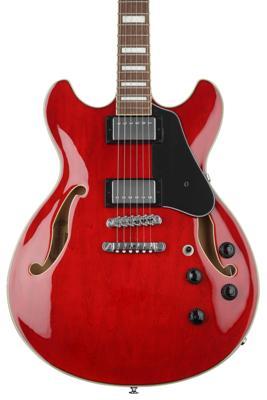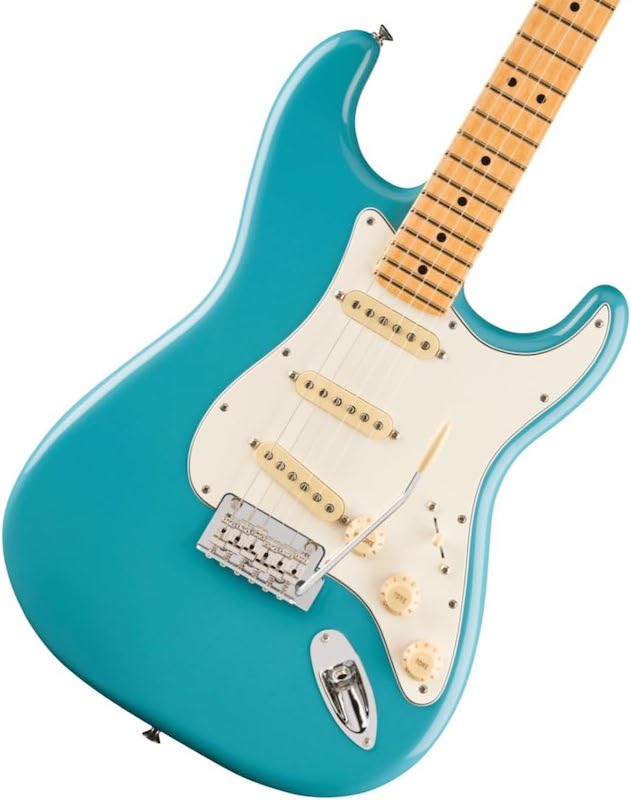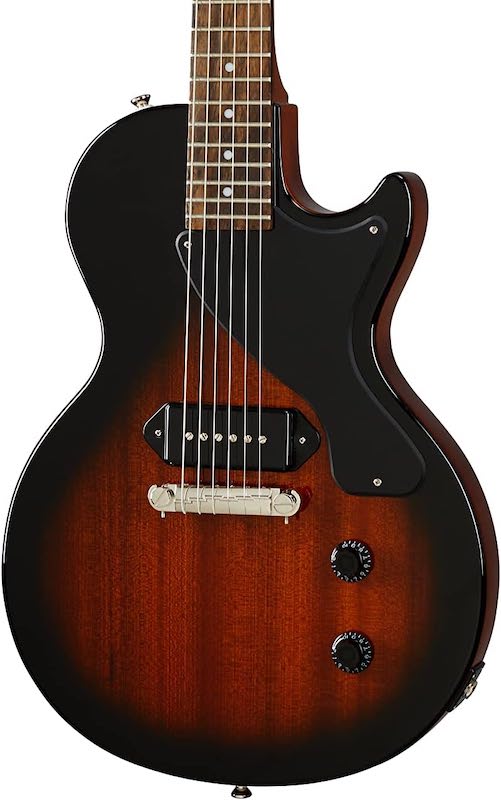Getting the perfect clean tone is not an easy task. As the popularity of VST amp plugins and high-output pickups has increased, it’s become increasingly difficult to get away from those harsh and brittle clean sounds and get back to those warm and luscious tube-like tones we love so much.
High-gain tones offer plenty of places to hide. When you’re playing clean, your technique needs to be great, and playing needs to be precise. You can’t get away with nearly as much.
That’s why, for a good clean tone, a suitable guitar is a must.
Top 3 - Guitars for Clean Tones
If the pickups break up too easily, or if the woods don’t have a balanced frequency output with enough bass, it can produce a harsh, scratchy, and even distorted sound that’s unpleasant to the ear. Likewise, guitars that aren’t easy to play won’t yield to your playing as easily, and will make it harder for you to play well with a clean sound.
While you do have a degree of control over certain tonal parameters on your amplifier, getting a guitar that naturally produces the right sound is going to make your playing experience much better as you’ll spend less time fighting your gear to get the tone you want.
So, to help fast-track your journey to finding a suitable guitar for clean tones, I’ve picked 7 of the very best axes in this department that I’ve either owned or extensively played on different occasions. Each guitar listed is thoroughly reliable and ideally suited to producing the most pleasant clean tones possible.
7 Best Guitars for Clean Tones - My Top Picks
1. Fender Player II Telecaster
It should come as no surprise that I’m a huge fan of the go-to country guitar for clean sounds. The Fender Telecaster might be the most widely heard clean guitar sound there is: think of all the massive country hits recorded on a Tele!
While I appreciate a high-end guitar as much as the next player, I want bang for buck with my instruments. The Fender Player II series acts as a nice middle ground for those who want something more premium feeling than a Squier, but aren’t quite willing to shell out for top-end Fenders.
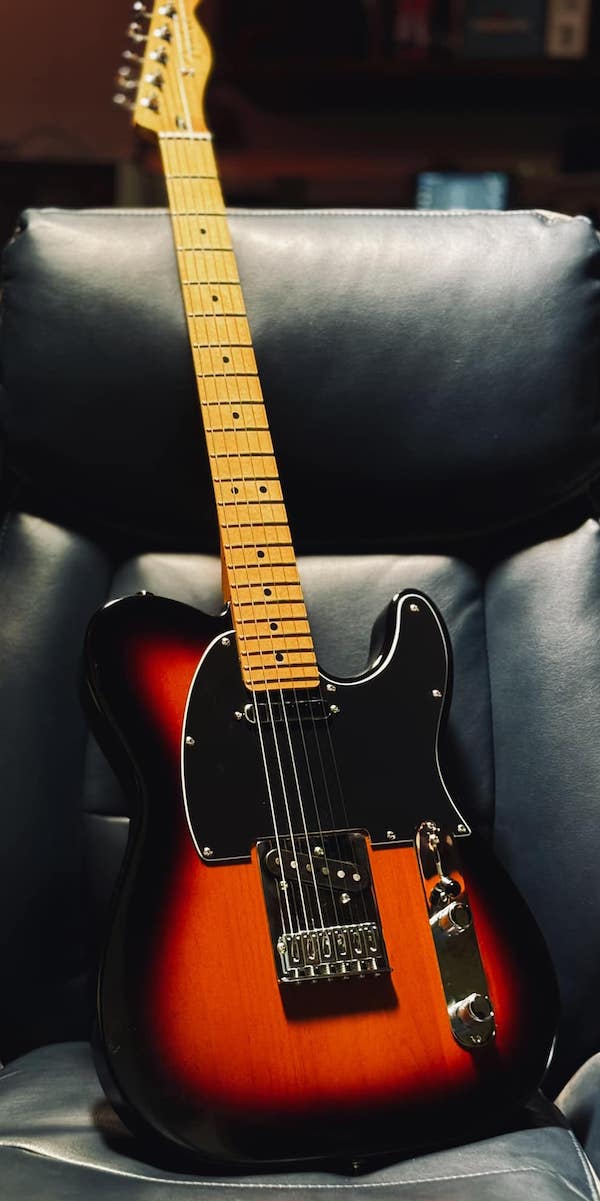
Fender Player II Telecaster
When I picked up the Player, the first thing I did was try out a few trusty Brent Mason licks. There is a particular kind of twangy clean tone associated with the Telecaster. When I started playing the intro riff from “Chattachoochee”, I noticed tons of top-end attack and teeth. I threw on my Keeley compressor and was instantly in country tone heaven.
Of course, the Tele is the go-to guitar for country lead playing, but it’s similarly well suited to blues and jazz as it has the lively and energetic tone those genres require. For jazz playing, I would recommend switching to the neck pickup and picking away from the bridge to counteract the guitar’s naturally treble-forward sound.
Most of the classic Tele tone on offer here comes from the traditional Telecaster pickup configuration. That means two single-coil pickups for the right pop and twang. The bridge pickup is nicely angled: this allows it to still be a little warmer on the bass side, while the treble side is extra twangy and metallic sounding thanks to the pickup sitting closer to the bridge than normal.
The clean tone here is best suited to country playing. All I needed to play along to the new Zach Top album was a tube amp, an analog delay, and my trusty Keeley compressor.
What I really liked about this is I could push a ton of energy and life out of the tone with zero breakup when I picked hard, so for any style of music where you need the guitar to be up-front and center while still being remaining clean, this is an ideal choice.
2. Gretsch G5222 Electromatic Double Jet
The 1950s and ‘60s were known as the golden era of Gretsch, where their distinct sound became an intrinsic part of certain musical genres such as rockabilly and country.
But their popularity has remained consistent throughout the years, as they offer a particular sound and feel that no other guitar can truly replicate.
As a huge AC/DC fan, I’ve always been fond of the Gretsch sound. I particularly like how Malcolm Young’s Duo Jet remains relatively clean at extremely high volumes through his Marshall amp.
I’ve always felt that the Duo Jet was Gretsch’s answer to the Gibson Les Paul. It even comes with Gretsch’s own Filter’Tron humbucking pickup to compete with the Gibson PAF.
What I noticed about the Jet every time I play one is how much harder it is to push it into breakup than any of my Les Pauls.
The Gretsch G5222 is one of the best mid-level instruments in their lineup, offering a fantastic entry point into the Gretsch sound at an affordable price that is still functional enough to be used by a professional.

Gretsch G5222 Electromatic Double Jet
I’m a big fan of the Electromatic line, which is for all intents and purposes Gretsch’s equivalent to Epiphone or Squier: a more affordable version of their premium classic instruments.
I’m very fond of the real Gretsch Filter’Tron, and this guitar comes with Broad’Tron pickups. These are very good humbuckers, with all the push and twang that I associate with Gretsch guitars.
I personally prefer the TV Jones Classic Plus, especially for country and rock playing. Regardless, the Broad’Trons are a gem at this price point, and you can read why in this dedicated article on our site. In short, if you're looking for pristine cleans, the G5222 surely won't disappoint!
When I played the Double Jet (of course, in a natural finish, like Malcolm Young’s) I was immediately struck by the warmth of its clean tone. I played some “Autumn Leaves” and even dense, extended jazz chords weren’t muffled by this guitar. Likewise, I was able to play some old-school Chet Atkins licks to my immense satisfaction.
This G5222 has a chambered mahogany body, the main benefit of which is making this guitar lighter. I’ve never noticed a major difference in sound with chambered as opposed to solid bodies. The maple top, however, does help balance out the natural warmth of the mahogany body. I never felt like the Double Jet was at risk of becoming overly boomy or warm like some hollowbodies do.
I will warn shredders who are used to playing as soft as possible that this guitar responds best to a harder touch. With the right amp, playing harder won’t push it into overdrive, but I found that it sounds much better when I play with a heavier pick and really dig in.
It’s a supremely balanced instrument and should be one of your first considerations if you’re looking for a hollow/chambered body. They sound exquisite!
3. Epiphone ES-335
When thinking about legendary hollowbody instruments, along with Gretsch you’ll almost always hear the Gibson 335 mentioned. The 335 is a classic that became extremely popular within genres like Jazz and Blues where dynamics and sweet-sounding clean tones were a must.
I typically use my 335 in my country band, where its tonal versatility really gets to shine.
I’ll be the first to admit that Gibson 335s are not exactly budget instruments. Thankfully we have Epiphone which offers their own 335-style guitar at a much more affordable price. At its price point, the finishes on offer look absolutely stunning to me, both in pictures and in real life.

Epiphone ES-335
While playing this guitar, it’s clear to me that it follows all the same principles as its bigger brother from Gibson. It has the tune-o-matic style bridge, and of course the semi-hollowbody design with the iconic F-holes. It also has individual tone and volume controls for each pickup, allowing for more detailed sculpting of your clean tone.
I’m very partial to using all four control knobs when playing live, especially in a covers setting. It’s nice to be able to dial back the brightness necessary for country lead playing when I switch to a blues solo, or vice versa, with the turn of a knob.
The sheer size of the all-maple body combined with the chambering gives it fantastic sustain and projection. It’s supremely bright and lively, but I was able to darken the sound down using the tone knobs.
It was awesome feeling the guitar reverberate against my body when I played a big, authoritative open G. That’s my favorite thing about hollowbodies, and I’ll never get sick of it!
As always, Epiphone’s pickups leave a little to be desired. The Alnico Classic PRO pickups are low-output and noise canceling, so I found myself enjoying a consistent and professional clean sound with no breakup. I was able to get in the ballpark of those classic tones of the ‘50s and ‘60s, but I’d recommend swapping them out for a something like Seymour Duncans.
The Epiphone 335 is dripping with old-school cool, and it plays great. I found myself really enjoying clean playing on this guitar. I spent hours enjoying BB King and Brent Mason licks alike on this guitar.
Read our complete Epiphone ES-335 review for more insights on this guitar.
4. Ibanez Artcore AS73
Now the keen-eyed among you will have already noticed that this is clearly just Ibanez’s own take on a 335. So what makes this a preferable choice over an actual Epiphone 335?
Ibanez first came to the attention of guitar buyers for building excellent copies of Gibson guitars. Why stop now?
Well, as with everything Ibanez does there are a few design choices on the Artcore AS73 that make it a contemporary instrument that’s more conducive to the modern player.

Ibanez Artcore AS73
There are some small aesthetic distinctions here such as the horns being a little more pointy and those nice chunky acrylic inlays which make it easier to see where you are on a dark stage.
There are also some practical adjustments too, such as the input jack being moved to the side so you can tuck it over your guitar strap. I actually prefer the front mount of the classic 335 jack, but this Les Paul-like placement is less obtrusive.
Instead of mahogany and maple, this guitar uses a glossy polyurethane finish over a linden body and top. I was playing around with the jazz inversions from “Moondance” and found this to have a more mid-focused frequency response and a little less dynamics than my 335. It’s still a very usable clean sound, but it’s not quite as warm and welcoming as I typically expect from a hollowbody.
I’m a big fan of Ibanez’s own Classic Elite Ceramic Humbucker. These higher-output humbuckers sound a little bit sharper and more direct than Gibson’s humbuckers. They do lean a bit too hard into the treble range at higher volumes for my liking, but for lower-volume playing such as in a jazz club, it’s a very usable tone.
The diecast plastic tuners and nut do feel a little cheap to the hands, but they are perfectly functional nonetheless.
I did enjoy playing the Ibanez Artcore, which feels comfortable and responsive in my hand. The overall playing experience is, to me, classic hollowbody, as well suited to high-speed jazz licks as to warm, welcoming blues riffs.
Like every guitar that Ibanez makes, this has been manufactured to the highest quality. The clean tones sound great and it holds tuning exceptionally well.
5. Fender Player II Stratocaster
The Fender Stratocaster re-defined what we thought was possible with electric guitars by providing unparalleled control over how the instrument sounds. The triple single coil design with a 5-way toggle switch allows for near-endless molding of your tone.
Traditionally, Stratocasters were quite pricey instruments, but these days we’re very fortunate to have actual Fender-branded Stratocasters available at an affordable price thanks to their Player II Series Strats.
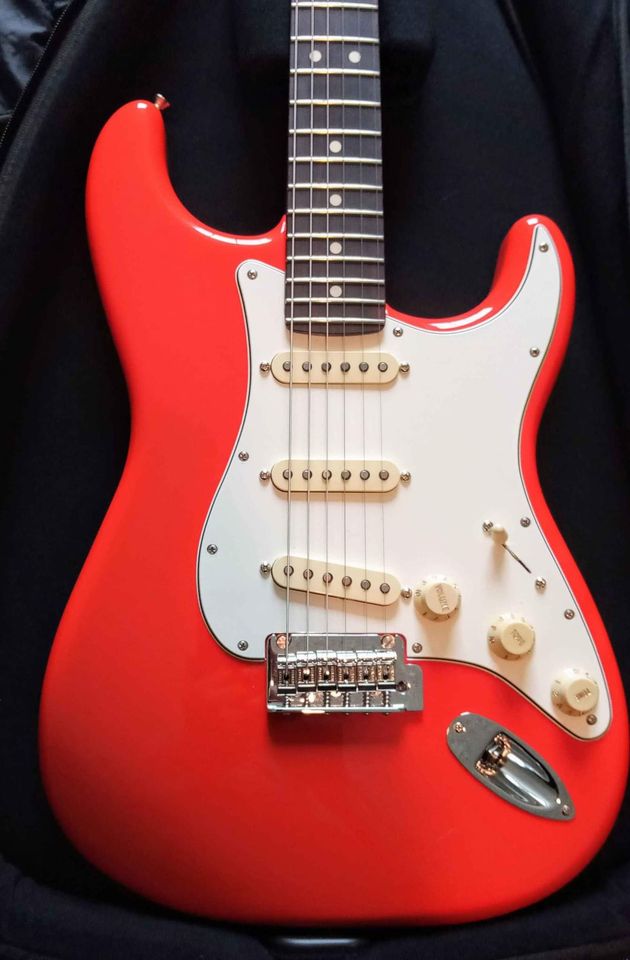
Fender Player II Stratocaster. This particular axe in the photo is the SSS variant with a Rosewood fingerboard.
It might be my age showing, but to me, the Strat is the popular clean guitar sound on mainstream radio. When I was growing up, the clean tone I heard most often in indie, pop, and rock hits was a Strat. It was the sound of the Red Hot Chili Peppers, John Mayer, and the Arctic Monkeys.
Upon picking up the Player II Strat, I was happy to note that this guitar flaunts everything we love about the Stratocaster. It has all the tonal controls and an upgraded tremolo bridge which provides fantastic tuning stability and sustain. The major perceived shortcoming is that these are made in Mexico as opposed to the USA.
Personally, I don’t mind this, especially given that the distance from Fender’s Mexico factory and its USA factory in California is only a few hours’ drive.
I was impressed that the fit and finish of this guitar is top notch and so is the playability. The finish doesn’t feel overly thick or sticky, and the neck is a comfortable, classic Fender C profile that feels good in my hand.
You’ll need to be a true guitar veteran to tell this apart from made-in-USA Strats when placed side by side without looking at the headstock.
You can get this guitar with both maple and rosewood fretboards. Although I personally prefer rosewood, one of the things that makes this Strat stand out a little is the maple fretboard. The finished maple fretboard does facilitate fast, smooth playing, and adds a little extra brightness and top end to the tone.
I found myself playing my favorite John Mayer riffs on this guitar and having plenty of fun enjoying the classic Strat snap and sparkle.
I was particularly impressed by the new Fender-Designed alnico pickups. I really want warm, glassy clean tones from a Strat, and that’s exactly what these delivered.
This guitar completely nails that trademark Strat sound, and thanks to the triple pickup configuration it’s also one of the most versatile guitars in existence. You’ll have no problems getting any kind of clean tone you want.
Of course, for higher gain applications, these bright single coils aren’t going to cut it.
If you’re an occasional player of grittier versions of rock, I’d recommend getting the HSS version of the same guitar which sports a potent humbucker in the bridge position.
6. Danelectro '59M NOS+
The Danelectro '59M NOS+ is certainly one of the more unique-looking guitars on the market, and the tone it produces is also very unique.
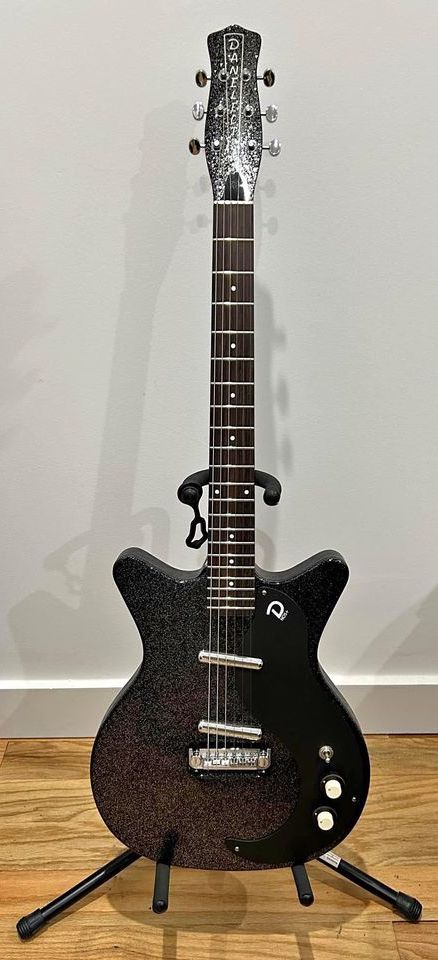
Danelectro '59M NOS+
Danelectro guitars exist in a realm of their own, in my experience. They aren’t trying to copy either of the main tried-and-tested Gibson or Fender guitar realms. Despite their reputation as a cheaper student-friendly instrument, the distinct Danelectro sound has its fans, myself included.
This is mainly due to the ‘lipstick’ style pickups which are not commonly found on electric guitars these days. Upon picking up this guitar, I was reminded that its pickups really do look like a tube of lipstick!
These pickups have a specific tonal quality which makes them bright, with a strong mid-range focus that gives them a snappy and lively attack.
Accordingly, this guitar is less suited for players who want a darker or more mellow Jazz sound. However, in a full band setting, I find that lipstick pickups slice right through the mix and command attention, making them a great, if unconventional, choice.
I will concede here that thee pickups run hotter than most single-coils. Amps like my Marshall that are prone to early breakup will do so here just like they would with a Les Paul.
However, through a clean Fender-style amp with plenty of headroom, this higher output allows for a lot of tonal options. They are noisier than my Les Paul’s humbuckers, especially with compression added.
When playing this guitar, I found myself fighting it a little more than I like. It’s not that it’s hard to play, but I had to dig in and concentrate a little more than, say, with a Telecaster.
That meant it was a little more work to maintain a consistent, articulate clean tone without it getting too bright or harsh.
This, for me, is a guitar that’s rewarding to play with the right attention and technique.
The action was a little high out of the box, but this can be a good thing. I actually tried out a few Derek Trucks-style slide licks and found the clear, sustaining tone here to be great for slide guitar. I didn’t need to add drive or compression to make the slides sustain properly: it just worked!
7. Epiphone Les Paul Junior
I know what you’re thinking. The Les Paul Junior, particularly with a P90, is a punk rock guitar. It’s for Green Day or Joan Jett power chords, not clean, funky tones.
I’ll be the first to admit that I was wrong about this punk rock workhorse. The Epiphone Les Paul Junior is a minimalist workhorse of a guitar and its sole P90 pickup offers a fantastic clean sound.
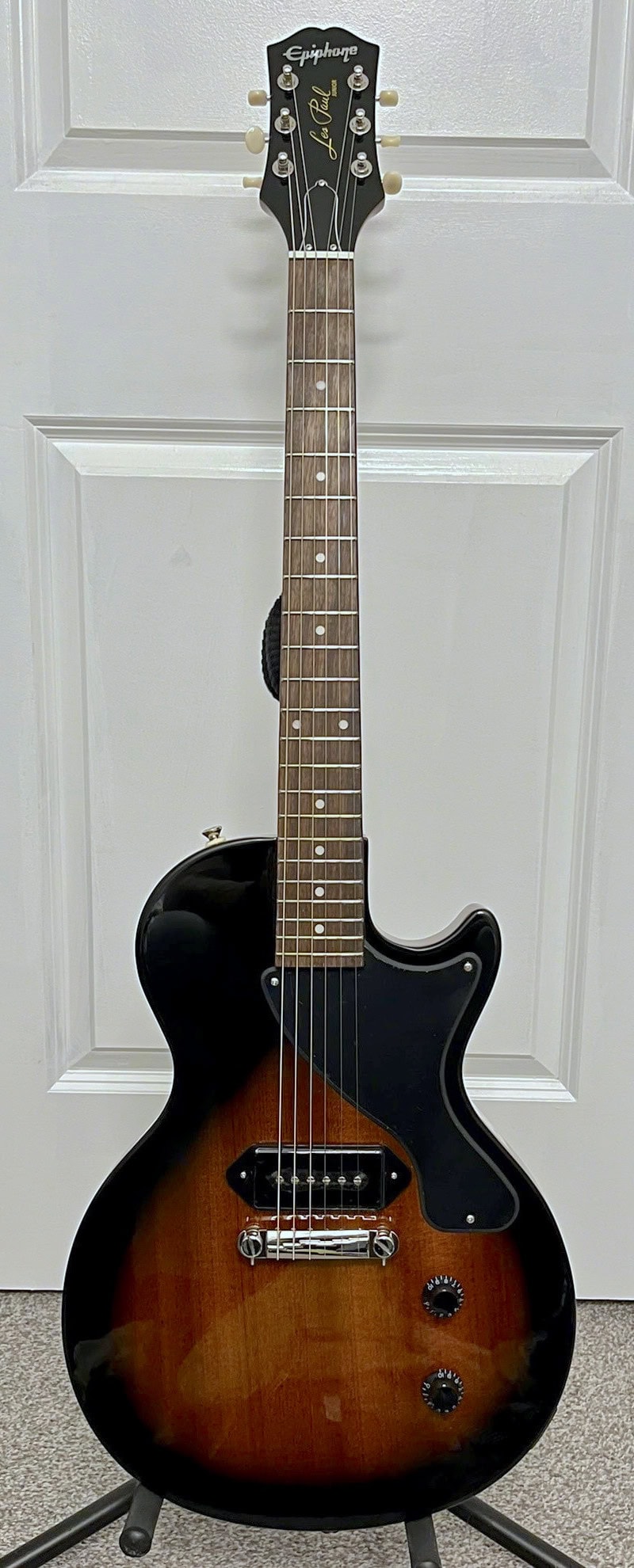
Epiphone Les Paul Junior
I love the sound of P90s, especially clean. They have enough single-coil snap to really encourage clean playing, with a little more warmth than I find on Fender guitars.
While the hefty neck and body are doing plenty of work to contribute to this guitar’s tone - it is a Les Paul, after all - I really feel that the hero of this instrument is the sole P90 pickup in the bridge.
There’s a great balance between clarity and warmth on offer that’s great for jazz playing. I ran through a few inversions and extended chords and found that the guitar sounded great with a few technique variations. I had to play closer to the neck and roll down the tone knob to get the warm jazzy tone I wanted, but it sounded awesome.
Likewise, when picking harder, towards the bridge, with the tone and volume knobs all the way up, I achieved a very satisfying country twang. It’s not quite as twangy and trebly as a Telecaster, but it’s definitely good enough to play Brent Mason licks in a country band.
The fretboard felt a little dry out of the box, but that’s nothing a little lemon oil can’t fix. This is a student-to-intermediate level guitar, so I mostly just expect playability and a nice tone.
A more luxurious playing experience is on offer with the Gold Glory, which is easier to play courtesy of its ebony fretboard, and sounds better thanks to its Seymour Duncan P90. I find the P90 in the Gold Glory to be warmer and more articulate than the Epiphone pickup, especially when hybrid picking harder as I tend to do with country leads.
Getting the most out of this guitar requires technique and playing adjustments, but that’s something I can really get behind. It’s the sort of instrument that will make anyone a better player by virtue of its limitations, and it offers a surprisingly broad array of awesome clean tones.
Which Aspects of a Guitar Influence the Clean Tone?
Depending on which particular type of clean tone you’re looking for, you can cater your guitar specification to help enhance those qualities.
While technically almost every single thing on a guitar influences the tone to some degree, when it comes to the big players that will form the bulk of your sound, there are 2 main aspects you should focus on.
Pickups
The first, and arguably largest, factor at play is the pickups. Depending on how they are wound and the magnet that’s used, their tonal output and dynamic qualities will differ. When choosing pickups specifically for a clean tone you ideally want to have low-output pickups in order to avoid something called ‘breakup’.
This is where when you pick hard you’ll hear just the tiniest bit of distortion as the clean tone begins to crack a little, the effect can be subtle on single notes, but as soon as you strum a big chord you’ll soon notice it.
By ensuring your guitar has low output pickups you can avoid the hassle of needing to tweak your amp or volume controls to address breakup problems.
As a general rule, single-coil pickups have a brighter sound, while humbuckers have a warmer sound. Single coils are heavily favored in genres where clean tones are a priority, but the warmer clean tone of humbuckers finds a home in jazz and blues circles, too.
Wood
The second factor is the wood that the guitar is made from. While this is certainly a subjective topic, taking some time to think about what kind of clean tone you like, whether it be something rich and thick, or something thin and twangy may make certain wood choices more of an appealing prospect than others.
But it’s worth remembering that woods are not your only opportunity to manipulate the frequency output of your tone, you will often have a 3-band EQ on your amp, or you can always use EQ pedals/post-processing to further address these things, so it’s not the end of the world if your guitar doesn’t have a specific wood combination.
With that being said, putting some thought into your wood choice so you can get yourself in the right tonal ballpark immediately is a good time saver as you’ll need to tweak less to reach your desired sound.
The most common wood you’ll see used for guitar bodies is mahogany, which is a dense and heavy wood that produces a rich, warm, and bass-heavy sound. You may also see Ash or Basswood which is lighter by comparison and accents more of the mids and highs.
Similarly, you may see maple used as a fretboard material which is also known to be bright and snappy. By comparison, rosewood or ebony will sound darker and warmer with more pronounced bass.
What Matters More, the Guitar or the Amp?
While having the right woods and pickups on your guitar is going to help you get to where you want to be quicker and easier, your amp gives you just as much control over your sound.
But will it get you into the tone you desire even if your guitar is not ideally suited to producing the type of tone you want?
This depends on the amplifier, but generally speaking, you should be able to manipulate the gain and EQ sections of an amplifier to get you to the tone you desire.
For example, if your pickups are super hot and you have a swamp ash body, leaving you with a clean tone that’s too bright and is breaking up when you pick hard, you can use your amplifier to dial back the gain, and then bring out the low end more using the onboard EQ.
So, while technically the amplifier is more important as it can effectively dial you into or out of any tone you want, the main difference is the amount of work required to get to that point.
Generally, I recommend clean-voiced tube amps for clean sounds. Fender and Vox amps have awesome, bright clean tones that stay clean even at higher volumes.
If you pick the right guitar, it’s going to sound pretty good as soon as you plug it in, which will save you a lot of time having to fight with your gear and tone chasing in order to get the desired sound. This prevents the headaches and frustration that come with having to mess around with your gear to compensate for the guitar's natural tone.
Keeping Things Clean
Getting the perfect clean tone for you can be a challenge if you don’t have the right gear. So putting some careful thought into picking a guitar with the right pickups, woods, and looks is going to dramatically improve your experience playing guitar.
Once you have a solid idea of what you’re looking for you’ll no doubt be able to find an instrument on this list that facilitates your needs. Have fun with your next guitar purchase!




